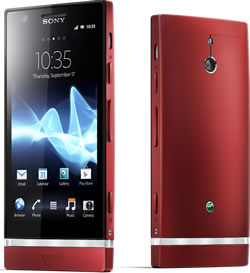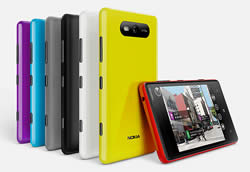Difference between Sony Xperia P and Nokia Lumia 820
Key difference: Sony Xperia P features a 4-inch TFT touch screen that allows up to 4-touch capabilities. The screen is scratch resistant and has a shatter proof coating. The touch screen provides approximately 275 ppi pixel density along with WhiteMagic technology, which adds an extra white pixel with the already present red, blue and green. One of the first smartphones under the brand is the Nokia Lumia 820. The Nokia Lumia 820 was first of the first phones to be developed running on Windows Phone 8. It was launched in November 2012, as a slightly cheaper alternative to the Nokia 920.
 Sony is a prominent technology company and is known best for its electronics such as phones, TVs, gaming systems, etc. The constant dynamic nature of technology ensures that we always have a better and more forward technology than the one we had a month ago. The price of this dynamic technology is also high, the constant updating of technology requires people have that much cash on hand. However, many companies such as Sony know that not many people have that much cash on hand for disposal, hence has launched mid-range phones such as Xperia P that allows the people to experience the best of both worlds: technology and affordable pricing. The Xperia P was launched in May 2012 and continues to be a major player in the market.
Sony is a prominent technology company and is known best for its electronics such as phones, TVs, gaming systems, etc. The constant dynamic nature of technology ensures that we always have a better and more forward technology than the one we had a month ago. The price of this dynamic technology is also high, the constant updating of technology requires people have that much cash on hand. However, many companies such as Sony know that not many people have that much cash on hand for disposal, hence has launched mid-range phones such as Xperia P that allows the people to experience the best of both worlds: technology and affordable pricing. The Xperia P was launched in May 2012 and continues to be a major player in the market.
Sony Xperia P features a 4-inch TFT touch screen that allows up to 4-touch capabilities. The screen is scratch resistant and has a shatter proof coating, allowing the screen to endure minor scratches and everyday scuffs without sacrificing on the quality. The touch screen provides approximately 275 ppi pixel density, though not the best ppi compared to the heavy contenders but the quality of the screen is not sacrificed. This is mostly because of the company’s WhiteMagic technology, which adds an extra white pixel with the already present red, blue and green. The extra pixel generates a higher level of brightness that does not cloud the phone when using it under direct sunlight.
The phone is a little bulky in nature, but it is easy to become accustomed to when holding it for longer periods of time. The phone is also a little heavier compared to similar phones, but again not something that lets the user forget of the other great features of the phone. The phone is encased in a plastic chassis, which is quite smooth to hold but is also prone to many visible scratches and chips. The device has a clear plastic border on the front that also as a cover up for the antenna. Above the plastic border reside buttons Home button, back button and Menu button. The power button, the volume rocker and the physical camera button is on the right side of the device, while the left sides hosts a variety of ports including the SIM card slot.
Under the hood, the device is powered by 1 GHz Dual-core processor and hosts the company’s Timescape UI. The user interface is quite smooth and does not glitch when shifting between the screens and the apps. The device runs on 1 GB RAM and comes with an internal storage capacity of 16 GB. Of the 16 GB, only 13 GB is available to the user and it is not expandable. The device houses an 8 MP Autofocus rear camera and a VGA (0.3 MP) front camera, which is a little bit of a letdown. The Exmor R technology ensures that the rear camera provides sharp, clear images, while the front camera does not live up to the same quality. Though initially powered by Android v2.3, the device is now available with Android v4.0, which no status as of yet for v4.1 upgrades. The phone also comes with additional features such as Motion gaming, MobiSystems’ OfficeSuite 5, Wi-Fi hotspot, DLNA, USB On-the-go, Native USB tethering and NFC capabilities. The Xperia P houses a non-removable 1305 mAh battery, which provides a decent battery life and lasts almost a day. With the amount of features that are offered with the phone, the price tag is expected to be quite high; however, the price is quite affordable and will not make that much of a dent in the user’s pocket.

Nokia is a multinational communications and information technology corporation based in Helsinki, Finland. Nokia’s phones have been famously known as being simple and durable. In 2012, it was the world’s second largest mobile phone maker by unit sales, following Samsung. However, the sales of Nokia have been decreasing as more and more of the market shifts towards smartphones such as iPhones and Androids. In an attempt to offset their decreasing sales, Nokia tied up with Microsoft to release its own line of smartphones, the Nokia Lumia running on Windows Phone Operating Software.
One of the first smartphones under the brand is the Nokia Lumia 820. The Nokia Lumia 820 was first of the first phones to be developed running on Windows Phone 8. It was launched in November 2012, as a slightly cheaper alternative to the Nokia Lumia 920. It has a 4.3 inch display with a resolution of 480 x 800 pixels. It is powered by a Qualcomm MSM8960 Snapdragon Dual-core 1.5 GHz Krait processor and a 1 GB RAM.
Nokia Lumia 820 features an 8 MP primary camera with autofocus and dual-LED flash, as well as Carl Zeiss optics. It also has a VGA secondary front-facing camera for self photo shots and video calling. The phone is available in a variety of bright colors, such as black, gray, red, yellow, white, blue, and violet. In fact, the phone comes with back panels in these colors allowing the user to change the phone’s color every few days.
The newest and most distinguishing feature of the Lumia 820 is that the phone is capable of wireless charging. However, the wireless charging mat is not included with the phone and has to be purchased separately.
However, the phone has been criticized as being chunky and heavy. Another issue with the phone, in fact all the Windows phones, is that it comes with the Internet Explorer browser built-in, which can be quite lagging at times, and the phones do not support any other browsers. Furthermore, the collection of apps available on Windows is quite limited, especially as compared to the apps available for Android and Apple.
The information for the detailed table about the two phones has been taken from Sony Mobile website, expertreviews.co.uk, Nokia website, cnet.co.uk and GSMArena.com.
|
|
Sony Xperia P |
Nokia Lumia 820 |
|
Launch Date |
May 2012 |
November 2012 |
|
Company |
Sony |
Nokia |
|
Size |
122 x 59.5 x 10.5 mm |
123.8 x 68.5 x 9.9 mm, 83.5 cc (4.87 x 2.70 x 0.39 in) |
|
Display |
4-inch scratch-resistant TFT touchscreen |
4.3 inches AMOLED capacitive touchscreen, |
|
Screen |
960 x 540 pixels (~275 ppi pixel density), 16 million colors |
480 x 800 pixels (~217 ppi pixel density) 16M colors |
|
Protection |
Scratch-resistant, shatter proof sheet on mineral glass |
ClearBlack display |
|
Weight |
120 grams |
160 g (5.64 oz) |
|
2G Network |
GSM GPRS/EDGE 850, 900, 1800, 1900 |
GSM 850 / 900 / 1800 / 1900 |
|
3G Network |
UMTS HSPA 850, 900, 1900, 2100 |
HSDPA 850 / 900 / 1900 / 2100 |
|
4G Network |
N/A |
LTE 800 / 900 / 1800 / 2100 / 2600 |
|
GUI |
Timescape UI |
Windows Phone 8 |
|
CPU speed |
1 GHz Dual core processor |
Dual-core 1.5 GHz Krait |
|
GPU |
Adreno 205 |
Adreno 225 |
|
OS |
Android OS, v2.3 (Gingerbread), v4.0 (Ice Cream Sandwich), planned upgrade to v4.1 (Jelly Bean) |
Microsoft Windows Phone 8 |
|
Chipset |
NovaThor U8500 |
Qualcomm MSM8960 Snapdragon |
|
RAM |
1GB |
1 GB RAM |
|
SIM Size |
microSIM |
Micro-SIM |
|
Internal Memory |
16 GB (13 GB accessible to the user) |
8 GB |
|
Expandable Memory |
N/A |
microSD, up to 64 GB |
|
Sensors |
Accelerometer, Proximity sensor, Ambient light sensor, Magnetometer and Gyroscope |
Accelerometer, gyro, proximity, compass |
|
Connectivity |
USB High speed 2.0 and Micro USB support, WiFi and WiFi Hotspot functionality, HDMI Support, DLNA Certified, Synchronisation via Exchange ActiveSync, Google Sync and Facebook, aGPS, WebKit web browser with Pan & zoom, Bluetooth technology, Native USB tethering and NFC. |
Micro-USB charging connector, 3.5 mm audio connector, Micro-USB-B connector, USB 2.0, Bluetooth 3.0, Wi-Fi, NFC, Wi-Fi Channel bonding |
|
Data |
GPRS, EDGE, WLAN, Bluetooth, NFC, USB. |
GPRS, EDGE, WLAN, Bluetooth, USB, NFC |
|
Speed |
GSM GPRS Up to 100 kbps; GSM EDGE Up to 296 kbps; UMTS HSPA cat 6 (upload) Up to 5.6 Mbps; UMTS HSPA cat 10(download) Up to 14.4 Mbps |
HSDPA, 42 Mbps; HSUPA, 5.76 Mbps; LTE, Cat3, 50 Mbps UL, 100 Mbps DL |
|
WLAN |
Wi-Fi 802.11 b/g/n, Wi-Fi hotspot, DLNA |
Wi-Fi 802.11 a/b/g/n, dual-band, Wi-Fi Direct |
|
Bluetooth |
Bluetooth v2.1 with A2DP, EDR |
Yes, v3.1 with A2DP, EDR |
|
USB |
microUSB v2.0, USB On-the-go |
microUSB v2.0 |
|
Primary Camera |
8 MP 3264x2448 pixels rear camera |
8 MP, 3264x2448 pixels |
|
Secondary Camera |
VGA front camera |
Yes, VGA |
|
Video |
HD video recording (1080p) |
Yes, 1080p@30fps, video stabilization |
|
Camera Features |
|
|
|
Sound Enhancement |
xLOUD Experience Clear bass and clear stereo |
Dolby Headphone sound enhancement, Active noise cancellation with dedicated mic |
|
Audio supported formats |
MP3, 3GPP, MP4, SMF, WAV, OTA, Ogg vorbis |
Codecs: MP3, AMR-WB, AMR-NB, WMA 10 Pro, WMA 9, AAC LC, AAC+/HEAAC, eAAC+/HEAACv2 Audio playback file formats: ASF, MP4, AAC, AMR, MP3, M4A, WMA, 3GP, 3G2 |
|
Video supported formats |
3GPP, MP4 |
Video playback codecs: VC-1, H.264/AVC, H.263, MPEG-4 Video playback file formats: MP4, WMV, 3GP, M4V Video recording formats: MP4/H.264 |
|
Battery Capacity |
Non-removable Li-Ion 1305 mAh battery |
Li-Ion 1650 mAh battery (BP-5T) |
|
Talk time |
2G: 6 hours 3G: 5 hours |
Maximum 2G talk time: 15.4 h Maximum 3G talk time: 8.1 h |
|
Stand-by |
2G: 470 hours 3G: 475 hours |
Maximum 3G standby time: 360 h |
|
Available Colors |
Black, Silver, Red |
Black, Gray, Red, Yellow, White, Blue, Violet |
|
Messaging |
SMS (threaded view), MMS, Email, IM, Push Email |
SMS (threaded view), MMS, Email, Push Email, IM |
|
Browser |
HTML5, Adobe Flash |
HTML5 |
|
Radio |
FM Radio with RDS |
No |
|
GPS |
GPS with A-GPS support |
Yes, with A-GPS support and GLONASS |
|
Java |
Java via Java MIDP emulator |
No |
|
Additional Features |
|
|
Image Courtesy: sonymobile.com, nokia.com









Add new comment